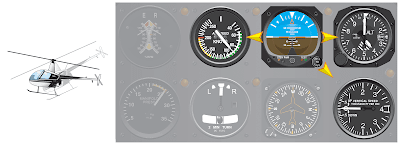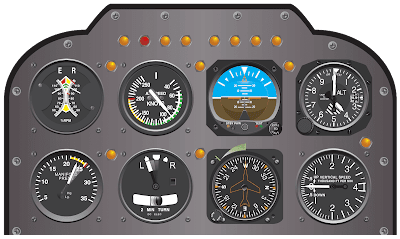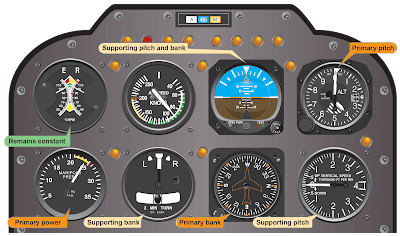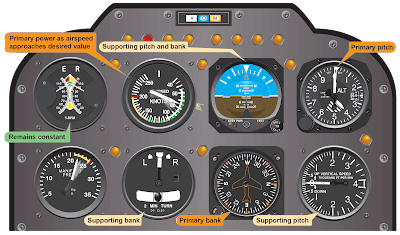Straight-and-level unaccelerated flight consists of maintaining the desired altitude, heading, airspeed, and pedal trim.
Pitch Control
The pitch attitude of a helicopter is the angular relation of its longitudinal axis to the natural horizon. If available, the attitude indicator is used to establish the desired pitch attitude. In level flight, pitch attitude varies with airspeed and center of gravity (CG). At a constant altitude and a stabilized airspeed, the pitch attitude is approximately level. [Figure 1]
 |
| Figure 1. The flight instruments for pitch control are the airspeed indicator, attitude indicator, altimeter, and vertical speed indicator |
Attitude Indicator
The attitude indicator gives a direct indication of the pitch attitude of the helicopter. In visual flight, attain the desired pitch attitude by using the cyclic to raise and lower the nose of the helicopter in relation to the natural horizon. During instrument flight, follow exactly the same procedure in raising or lowering the miniature aircraft in relation to the horizon bar.
There is some delay between control application and resultant instrument change. This is the normal control lag in the helicopter and should not be confused with instrument lag. The attitude indicator may show small misrepresentations of pitch attitude during maneuvers involving acceleration, deceleration, or turns. This precession error can be detected quickly by cross-checking the other pitch instruments. If the miniature aircraft is properly adjusted on the ground, it may not require readjustment in flight. If the miniature aircraft is not on the horizon bar after level off at normal cruising airspeed, adjust it as necessary while maintaining level flight with the other pitch instruments. Once the miniature aircraft has been adjusted in level flight at normal cruising airspeed, leave it unchanged so it gives an accurate picture of pitch attitude at all times.
Altimeter
The altimeter gives an indirect indication of the pitch attitude of the helicopter in straight-and-level flight. Since the altitude should remain constant in level flight, deviation from the desired altitude indicates a need for a change in pitch attitude and power as necessary. When losing altitude, raise the pitch attitude and adjust power as necessary. When gaining altitude, lower the pitch attitude and adjust power as necessary. Indications for power changes are explained in the next paragraph.
The rate at which the altimeter moves helps to determine pitch attitude. A very slow movement of the altimeter indicates a small deviation from the desired pitch attitude, while a fast movement of the altimeter indicates a large deviation from the desired pitch attitude. Make any corrective action promptly with small control changes. Also, remember that movement of the altimeter should always be corrected by two distinct changes. The first is a change of attitude to stop the altimeter movement; the second is a change of attitude to return smoothly to the desired altitude. If altitude and airspeed are more than 100 feet and 10 knots low, respectively, apply power in addition to an increase of pitch attitude. If the altitude and airspeed are high by more than 100 feet and 10 knots, reduce power and lower the pitch attitude. There is a small lag in the movement of the altimeter; however, for all practical purposes, consider that the altimeter gives an immediate indication of a change or a need for change in pitch attitude. Since the altimeter provides the most pertinent information regarding pitch in level flight, it is considered primary for pitch.
Vertical Speed Indicator (VSI)
The VSI gives an indirect indication of the pitch attitude of the helicopter and should be used in conjunction with the other pitch instruments to attain a high degree of accuracy and precision. The instrument indicates zero when in level flight. Any movement of the needle from the zero position shows a need for an immediate change in pitch attitude to return it to zero. Always use the VSI in conjunction with the altimeter in level flight. If a movement of the VSI is detected, immediately use the proper corrective measures to return it to zero. If the correction is made promptly, there is usually little or no change in altitude. If the needle of the VSI does not indicate zero, the altimeter indicates a gain or loss of altitude.
The initial movement of the vertical speed needle is instantaneous and indicates the trend of the vertical movement of the helicopter. A period of time is necessary for the VSI to reach its maximum point of deflection after a correction has been made. This time element is commonly referred to as instrument lag. The lag is directly proportional to the speed and magnitude of the pitch change. When employing smooth control techniques and small adjustments in pitch attitude are made, lag is minimized, and the VSI is easy to interpret.
Overcontrolling can be minimized by first neutralizing the controls and allowing the pitch attitude to stabilize, then readjusting the pitch attitude by noting the indications of the other pitch instruments.
Occasionally, the VSI may be slightly out of calibration. This could result in the instrument indicating a slight climb or descent even when the helicopter is in level flight. If the instrument cannot be calibrated properly, this error must be taken into consideration when using the VSI for pitch control. For example, if a descent of 100 feet per minute (fpm) is the vertical speed indication when the helicopter is in level flight, use that indication as level flight. Any deviation from that reading would indicate a change in attitude.
Airspeed Indicator
The airspeed indicator gives an indirect indication of helicopter pitch attitude. With a given power setting and pitch attitude, the airspeed remains constant. If the airspeed increases, the nose is too low and should be raised. If the airspeed decreases, the nose is too high and should be lowered. A rapid change in airspeed indicates a large change in pitch attitude, and a slow change in airspeed indicates a small change in pitch attitude. There is very little lag in the indications of the airspeed indicator. If, while making attitude changes, there is some lag between control application and change of airspeed, it is most likely due to cyclic control lag. Generally, a departure from the desired airspeed, due to an inadvertent pitch attitude change, also results in a change in altitude. For example, an increase in airspeed due to a low pitch attitude results in a decrease in altitude. A correction in the pitch attitude regains both airspeed and altitude.
Bank Control
The bank attitude of a helicopter is the angular relation of its lateral axis to the natural horizon. To maintain a straight course in visual flight, keep the lateral axis of the helicopter level with the natural horizon. Assuming the helicopter is in coordinated flight, any deviation from a laterally level attitude produces a turn. [Figure 3]
 |
| Figure 3. The flight instruments used for bank control are the attitude, heading, and turn indicators |
Attitude Indicator
The attitude indicator gives a direct indication of the bank attitude of the helicopter. For instrument flight, the miniature aircraft and the horizon bar of the attitude indicator are substituted for the actual helicopter and the natural horizon. Any change in bank attitude of the helicopter is indicated instantly by the miniature aircraft. For proper interpretation of this instrument, imagine being in the miniature aircraft. If the helicopter is properly trimmed and the rotor tilts, a turn begins. The turn can be stopped by leveling the miniature aircraft with the horizon bar. The ball in the turn-and-slip indicator should always be kept centered through proper pedal trim.
The angle of bank is indicated by the pointer on the banking scale at the top of the instrument. Small bank angles, which may not be seen by observing the miniature aircraft, can easily be determined by referring to the banking scale pointer.
Pitch-and-bank attitudes can be determined simultaneously on the attitude indicator. Even though the miniature aircraft is not level with the horizon bar, pitch attitude can be established by observing the relative position of the miniature aircraft and the horizon bar. [Figure 4]
 |
| Figure 4. The banking scale at the top of the attitude indicator indicates varying degrees of bank. In this example, the helicopter is banked approximately 15° to the right |
The attitude indicator may show small misrepresentations of bank attitude during maneuvers that involve turns. This precession error can be detected immediately by closely cross-checking the other bank instruments during these maneuvers. Precession is normally noticed when rolling out of a turn. If, upon completion of a turn, the miniature aircraft is level and the helicopter is still turning, make a small change of bank attitude to center the turn needle and stop the movement of the heading indicator.
Heading Indicator
In coordinated flight, the heading indicator gives an indirect indication of a helicopter’s bank attitude. When a helicopter is banked, it turns. When the lateral axis of a helicopter is level, it flies straight. Therefore, in coordinated flight when the heading indicator shows a constant heading, the helicopter is level laterally. A deviation from the desired heading indicates a bank in the direction the helicopter is turning. A small angle of bank is indicated by a slow change of heading; a large angle of bank is indicated by a rapid change of heading. If a turn is noticed, apply opposite cyclic until the heading indicator indicates the desired heading, simultaneously ensuring the ball is centered. When making the correction to the desired heading, do not use a bank angle greater than that required to achieve a standard rate turn. In addition, if the number of degrees of change is small, limit the bank angle to the number of degrees to be turned. Bank angles greater than these require more skill and precision in attaining the desired results. During straight-and-level flight, the heading indicator is the primary reference for bank control.
Turn Indicator
During coordinated flight, the needle of the turn-and-slip indicator gives an indirect indication of the bank attitude of the helicopter. When the needle is displaced from the vertical position, the helicopter is turning in the direction of the displacement. Thus, if the needle is displaced to the left, the helicopter is turning left. Bringing the needle back to the vertical position with the cyclic produces straight flight. A close observation of the needle is necessary to accurately interpret small deviations from the desired position.
Cross-check the ball of the turn-and-slip indicator to determine if the helicopter is in coordinated flight. [Figure 5] If the rotor is laterally level and pedal pressure properly compensates for torque, the ball remains in the center. To center the ball, level the helicopter laterally by reference to the other bank instruments, then center the ball with pedal trim. Torque correction pressures vary as power changes are made. Always check the ball after such changes.
Common Errors During Straight-and-Level Flight
- Failure to maintain altitude
- Failure to maintain heading
- Overcontrolling pitch and bank during corrections
- Failure to maintain proper pedal trim
- Failure to cross-check all available instruments
Power Control During Straight-and-Level Flight
Establishing specific power settings is accomplished through collective pitch adjustments and throttle control, where necessary. For reciprocating-powered helicopters, power indication is observed on the manifold pressure gauge. For turbine-powered helicopters, power is observed on the torque gauge.
At any given airspeed, a specific power setting determines whether the helicopter is in level flight, in a climb, or in a descent. For example, cruising airspeed maintained with cruising power results in level flight. If a pilot increases the power setting and holds the airspeed constant, the helicopter climbs. Conversely, if the pilot decreases power and holds the airspeed constant, the helicopter descends.
If the altitude is held constant, power determines the airspeed. For example, at a constant altitude, cruising power results in cruising airspeed. Any deviation from the cruising power setting results in a change of airspeed. When power is added to increase airspeed, the nose of the helicopter pitches up and yaws to the right in a helicopter with a counterclockwise main rotor blade rotation. [Figure 6] When power is reduced to decrease airspeed, the nose pitches down and yaws to the left. [Figure 7] The yawing effect is most pronounced in single-rotor helicopters and is absent in helicopters with counter-rotating rotors. To counteract the yawing tendency of the helicopter, apply pedal trim during power changes.
 |
| Figure 6. Flight instrument indications in straight and level flight with power increasing |
 |
| Figure 7. Flight instrument indications in straight and level flight with power decreasing |
To maintain a constant altitude and airspeed in level flight, coordinate pitch attitude and power control. The relationship between altitude and airspeed determines the need for a change in power and/or pitch attitude. If the altitude is constant and the airspeed is high or low, change the power to obtain the desired airspeed. During the change in power, make an accurate interpretation of the altimeter, then counteract any deviation from the desired altitude by an appropriate change of pitch attitude. If the altitude is low and the airspeed is high, or vice versa, a change in pitch attitude alone may return the helicopter to the proper altitude and airspeed. If both airspeed and altitude are low, or if both are high, changes in both power and pitch attitude are necessary.
 |
| Figure 8. Flight instrument indications in straight and level flight at normal cruise speed |
 |
| Figure 9. Flight instrument indications in straight and level flight with airspeed decreasing |
The altimeter is the primary pitch instrument during level flight, whether flying at a constant airspeed or during a change in airspeed. Altitude should not change during airspeed transitions, and the heading indicator remains the primary bank instrument. Whenever the airspeed is changed by an appreciable amount, the manifold pressure gauge is momentarily the primary instrument for power control. When the airspeed approaches the desired reading, the airspeed indicator again becomes the primary instrument for power control.
To produce straight-and-level flight, the cross-check of the pitch-and-bank instruments should be combined with the power control instruments. With a constant power setting, a normal cross-check should be satisfactory. When changing power, the speed of the cross-check must be increased to cover the pitch and bank instruments adequately. This is necessary to counteract any deviations immediately.
Common Errors During Airspeed Changes
- Improper use of power
- Overcontrolling pitch attitude
- Failure to maintain heading
- Failure to maintain altitude
- Improper pedal trim


